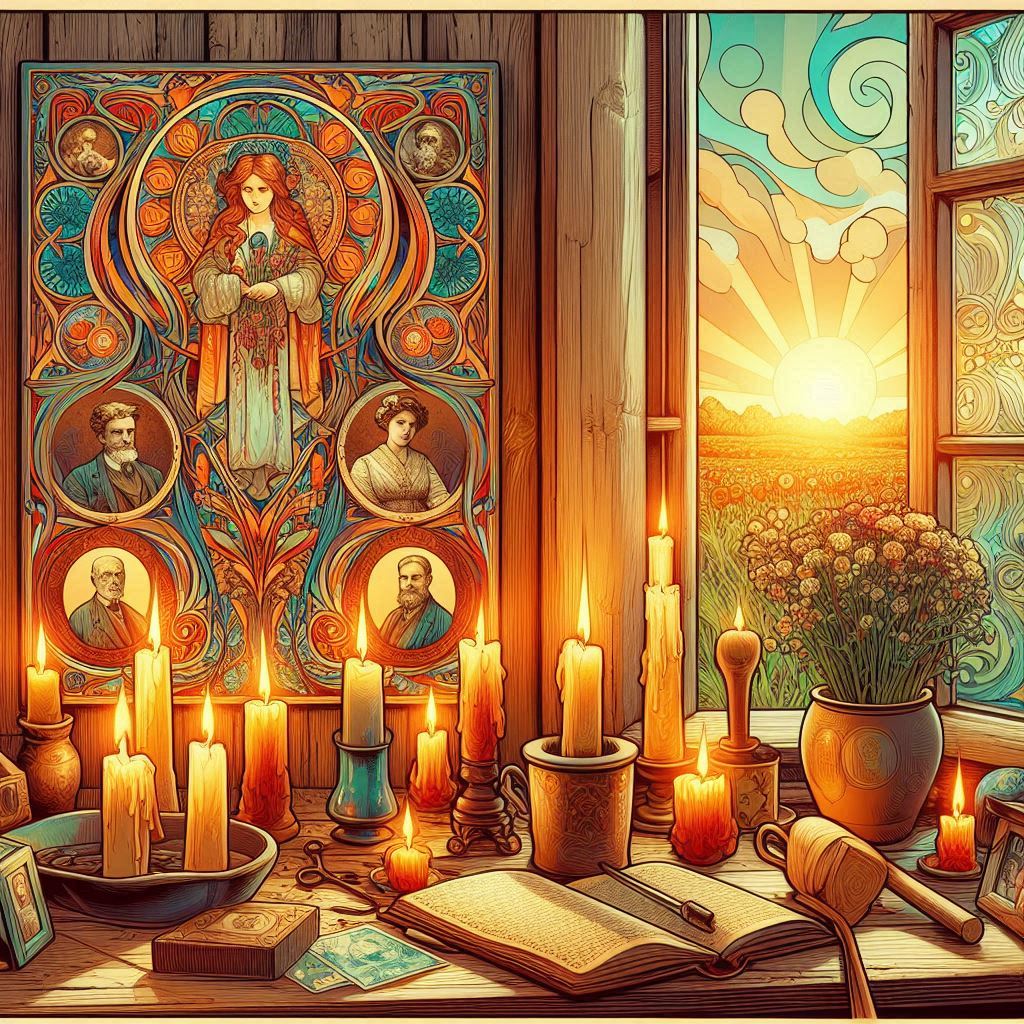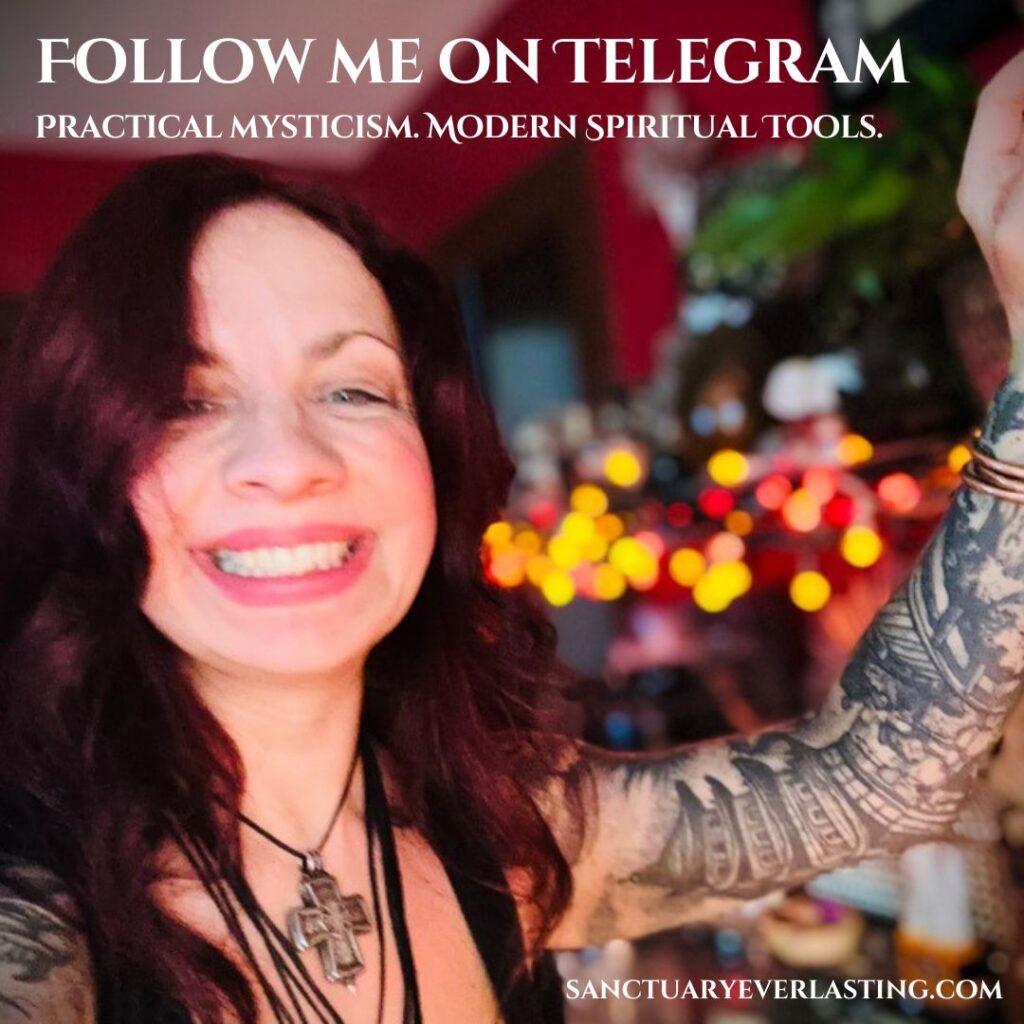Samhain is coming…and the veil is thinning.
It’s a season of both harvest and remembrance.
When the ancestors walk closer to us, and our intuition heightens.
Creating an ancestral altar at this time of year is one of the most profound ways to honor those who came before you.
Work with it to call in guidance and weave your energy into the cycles of death, rebirth, and renewal.
This guide will take you deep into the why and how of ancestral altar work.
You’ll learn practical steps to create your own sacred space.
I also included a short meditation to help you connect with your lineage and receive wisdom from beyond the veil.
The Power of the Ancestral Season
The Descent

Autumn has long been associated with descent.
Persephone’s journey to the underworld, the Day of the Dead in Mexico, and Samhain in the Celtic wheel of the year all mark this time as one for remembering the dead.
When the sun moves lower in the sky, our attention naturally turns inward.
The harvest is gathered, the fields grow bare, and we become more aware of mortality and impermanence.
This natural rhythm creates a liminal space, where boundaries soften between the living and the dead.
Many cultures saw this as a time to light fires, set out offerings, and invite ancestors into the home.
You can work with this energy by consciously building a space where you honor your ancestors and beloved dead and invite their blessings.
Your ancestral altar can be as simple (a photo on a table with a candle) or complex as you want it to be. Let’s get started.
Why Build an Ancestral Altar?

So, an altar isn’t just a pretty arrangement.
It’s a portal.
It’s a living energetic space that allows communication, reflection, and reverence.
- Connection: Altars create a focal point for prayer, meditation, and ritual.
- Healing: Ancestral work can help you release inherited trauma and patterns.
- Guidance: You may receive inspiration, dreams, or synchronicities when you engage with your ancestors regularly.
- Continuity: Honoring those who came before you strengthens your sense of place in the great web of life.
Choosing the Location for Your Ancestral Altar
The first step in building an ancestral altar is deciding where it will live in your home.
- Quiet Corner: Choose a place that feels respectful and peaceful. A shelf, table, or cabinet works well.
- Protection: If you share space with others, consider a place where pets and children won’t disturb it.
- Energetic Alignment: If you can swing it, West is traditionally a good direction for ancestral work.
The West as the Direction of Ancestors

Symbolism of the West
In many esoteric and spiritual traditions, the West is the direction of endings, descent, and the setting sun.
- Element of Water: The West is associated with water, the element of memory, emotion, intuition, and the unconscious. Working in this direction can deepen your ability to feel into ancestral presence and receive intuitive messages.
- The Land of the Dead: In ancient Egypt, the west bank of the Nile was the place of burial. The sun “died” in the West each day, so tombs and necropolises were placed there. The West became the land of the ancestors and spirits.
- The Inner Journey: The West corresponds to dusk, dreamtime, and the gateway to the underworld in many shamanic and indigenous traditions. Setting your altar here energetically opens that liminal doorway.
Seasonal Alignment
Autumn itself is also a “western” season on the Wheel of the Year.
- Harvest and Release: Just as the sun moves westward and the days grow shorter, this is the time of harvesting what has grown and letting go of what must die.
- Descent into Mystery: Aligning your altar with the West harmonizes it with the natural cycle of descent and prepares you for Samhain, when the veil is thinnest.
Practical Benefit
- If your home has a West-facing window, your altar can receive the glow of the setting sun. It’s a beautiful, natural signal for your ritual practice.
- Psychologically, facing West during meditation can bring a sense of completion, rest, and surrender, which can be helpful when connecting with ancestors.
Gathering Your Ancestral Altar Materials

You don’t need anything elaborate. Just a few thoughtful pieces that hold meaning.
Core Components
- Photographs or Mementos: Images of your ancestors, heirlooms, or objects that remind you of them.
- Light Source: A candle or small lantern — the element of fire acts as a bridge between worlds in this case.
- Offering Dish: A small bowl or plate for food, flowers, or symbolic gifts.
- Cloth: A special cloth or scarf to serve as the foundation for the altar.
Seasonal Touches
Because this is autumn work, you can also add harvest symbols if you like (but you don’t need to). Consider using:
- Small pumpkins or gourds
- Dried corn or grain stalks
- Acorns, autumn leaves, pinecones
- A glass of cider, wine, or water
Energetic Additions
Again, nice to have, but not at all required.
- Crystals: Try obsidian, smoky quartz, or black tourmaline for protection.
- Incense: Frankincense, myrrh, copal, or mugwort for clearing.
- Bells, Chimes, or a Tibetan Singing Bowl: For opening and closing the space.
Step-by-Step Altar Construction

- Cleanse your Space: Smudge with sacred smoke, ring a bell, or simply clap your hands and say something like, “I clear this space and make way for love and remembrance.”
- Lay the Cloth: Choose one in a color that feels right to you (black for mystery, white for purity, gold for harvest, red for bloodline connection, etc.).
- Place Your Anchors: Position your candle or lantern first, then your offering dish.
- Arrange Photos and Mementos: Center them so they feel honored.
- Add Your Seasonal Elements: If you’re using them, surround your photos with autumn symbols, as though creating a nest.
- Invite the Energy: Speak aloud the names of the ancestors you are calling in, or simply say, “I welcome the wise ones of my blood and spirit. All my ancestors who love me are welcome.”
- Offer Light: Light the candle, dedicating the flame to the connection between realms.
Working with Your Ancestral Altar
Building the altar is just the beginning. It’s a living space that benefits from daily or weekly attention.
The main idea is this: Just as you wouldn’t neglect your living relatives, don’t neglect your ancestral altar.
- Refresh Offerings: Replace food or drink offerings regularly.
- Speak and Listen: Spend time in quiet reflection, talking to your ancestors or listening for their messages.
- Journal: Keep a notebook near your altar to record dreams, insights, or synchronicities.
- Celebrate: Mark significant dates (birthdays, death anniversaries) by lighting candles or placing flowers.
What to Offer

Offerings can be simple and heartfelt. The key is sincerity. Try using:
- Fresh water
- Bread, fruit, or chocolate
- A sip of wine or whiskey
- Seasonal herbs like rosemary (for remembrance) or sage (for clearing)
- Handwritten letters of gratitude
- A favorite food or drink of your ancestors
Protection and Boundaries
Ancestral work is potent, so create clear boundaries.
- Close the Space: Extinguish candles mindfully when finished.
- Energetic Wards: Place protective stones at the corners of the altar.
- Set Intentions: State aloud that you invite only benevolent, loving ancestors.
Simple Meditation to Connect with Your Ancestors

Try this short meditation whenever you sit at your altar.
1. Settle In: Sit comfortably with your spine straight. Close your eyes and take three deep breaths.
2. Visualize: Imagine roots growing from your spine deep into the earth. Feel yourself anchored.
3. Call Them In: Picture a doorway opening in your heart. Silently invite your loving ancestors to step forward.
4. Sense: Notice any feelings, images, scents, or memories that arise.
5. Listen: Ask, “What wisdom do you have for me right now?” Sit quietly and receive whatever comes.
6. Close: Thank them for their presence, visualize the doorway gently closing, and blow out your candle.
Integrating Ancestral Guidance
Connecting with ancestors isn’t just about ritual.
It’s about allowing their wisdom to flow into your life.
After meditating, consider:
- What choices or patterns am I carrying that are theirs — and do I want to keep them?
- What blessings or talents run in my lineage that I can embody more fully?
- How can I honor them through action — storytelling, cooking ancestral foods, preserving traditions?
- What generational patterns no longer serve me that I want to release?
Seasonal Rhythm and Ongoing Practice
If you choose to keep it up year round, your altar can shift with the seasons.
Add evergreen boughs at Yule, fresh flowers at Beltane, or sun symbols at midsummer.
The key is consistency.
Each time you visit, you deepen the bridge between worlds, and your ancestors learn that they have a place in your daily life.
Weaving the Web Between Worlds

Building an ancestral altar is a simple but profound act of magic.
It roots you in your lineage, reminds you that you’re not alone, and allows healing to flow across time.
As the veil thins this October, use this altar as your compass.
It’s a place to sit in silence, to grieve, to celebrate, and to ask for guidance.
Your ancestors are never far away. They’re waiting to walk beside you.
All you need to do is light the candle, open your heart, and invite them in.


